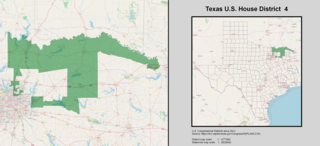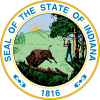
Julia May Carson was an American politician who served as a member of the United States House of Representatives for Indiana's 7th congressional district from 1997 until she died in 2007. Carson was the first woman and first African American to represent Indianapolis in the U.S. Congress. She was also the second African American woman elected to Congress from Indiana, after Katie Hall, and her grandson André Carson succeeded to her seat following her death.

Texas's 4th congressional district of the United States House of Representatives is in an area of Northeast Texas, that includes some counties along the Red River northeast of the Dallas/Fort Worth Metroplex, as well as some outer eastern suburbs of the Metroplex. Austin College in Sherman, Texas is located within the district. As of 2017, the 4th district represents 747,188 people who are predominantly white (80.8%) and middle-class . It is currently represented by Pat Fallon.
New York's 9th congressional district is a congressional district for the United States House of Representatives in New York City, represented by Yvette Clarke.
New York's 15th congressional district for the United States House of Representatives is located in New York City, State of New York. The district has been represented by Democrat Ritchie Torres since 2021. It is the poorest congressional district in the United States.

New York's 16th congressional district is a congressional district for the United States House of Representatives represented by George Latimer.

New York's 25th congressional district is a congressional district for the United States House of Representatives. It is currently represented by Democrat Joseph Morelle. Since 2023, the district has been located within Monroe County and part of Orleans County, centered on the city of Rochester.

The 2004 United States presidential election in Indiana took place on November 2, 2004, and was part of the 2004 United States presidential election. Voters chose 11 representatives, or electors to the Electoral College, who voted for president and vice president.

Pennsylvania's 12th congressional district is located in southwestern Pennsylvania, including Pittsburgh and much of Allegheny County, as well as some of Westmoreland County. Since January 3, 2023, it has been represented by Summer Lee.

Indiana's 7th congressional district is a congressional district in the U.S. state of Indiana. It is entirely located within Marion County and includes most of Indianapolis, except for the southern side, which is located within the 6th district.

Connecticut is divided among five congressional districts from which citizens elect the state's representatives to the United States House of Representatives. After the re-apportionment following the 2000 census, Connecticut lost one representative, reducing the state's delegation from six to five. The redistricting process was shared between the Republican governor at the time, John G. Rowland, and the Democratic-controlled General Assembly. Before the census, the state's House delegation was split evenly between Republicans and Democrats, and the solution finally agreed upon by the redistricting committee would ensure an even match-up between incumbents, the 6th district's Nancy L. Johnson, a Republican, and the 5th district's James H. Maloney, a Democrat. In the 2002 elections, Johnson defeated Maloney by a surprisingly large margin in the new 5th district.

The 2008 congressional elections in Indiana were held on November 4, 2008, to determine who will represent the State of Indiana in the United States House of Representatives. Indiana has nine seats in the House, apportioned according to the 2000 United States census. Representatives are elected for two-year terms; those elected will serve in the 111th Congress from January 3, 2009, until January 3, 2011. The elections coincide with the 2008 U.S. presidential election.

The 2008 United States presidential election in Indiana took place on November 4, 2008, and was part of the 2008 United States presidential election. Voters chose 11 representatives, or electors to the Electoral College, who voted for president and vice president.

The government of Indiana is established and regulated by the Constitution of Indiana. The state-level government consists of three branches: the judicial branch, the legislative branch, and the executive branch. The three branches share power and jointly govern the state of Indiana. County and local governments are also constitutional bodies with limited authority to levy taxes, pass legislation, and create and maintain local public infrastructure.
Indiana is one of fifty U.S. states. The state is considered a stronghold for the Republican Party and is rated R+11 on the Cook Partisan Voting Index. The state has supported the Republican candidate in every presidential election since 1968, with the exception of 2008. Republicans also currently hold supermajorities in both chambers of the Indiana General Assembly and have dominated the governorship since 2005. Indiana was once a swing state in the 19th century and early 20th century, voting for the national winner from 1852 to 1912, with the exception of 1876.

The 2006 congressional elections in Indiana were elections for Indiana's delegation to the United States House of Representatives, which occurred along with congressional elections nationwide on November 7, 2006. Indiana played an important role in helping Democrats sweep Congress, when three Republican incumbents were defeated, giving the Democrats a majority of the delegation again. Republicans held a majority of Indiana's delegation, 7–2, before the elections.

The 2002 congressional elections in Indiana were elections for Indiana's delegation to the United States House of Representatives, which occurred along with congressional elections nationwide on November 5, 2002. Republicans held a majority of Indiana's delegation, 6-4, before the elections. The districts were redrawn prior to the 2002 elections, reducing the number of districts by 1. Democrat Tim Roemer of the 2nd district retired, leaving the seat vacant. Republicans picked up the 2nd district seat, gaining a 6-3 advantage following the elections.

The 2010 congressional elections in Indiana were held on November 2, 2010, to determine who would represent the state of Indiana in the United States House of Representatives. Representatives are elected for two-year terms; those elected served in the 112th Congress from January 2011 until January 2013, except for the winner of the 3rd District's special election, who will serve the few remaining weeks of the 111th Congress. As of 2023 this is the last time that the Democrats won more than 2 seats in Indianas house delegation.

Frank Dean Lucas is an American politician serving as the U.S. representative for Oklahoma's 3rd congressional district since 2003, having previously represented the 6th district from 1994 to 2003. A member of the Republican Party, Lucas has chaired the House Committee on Science, Space and Technology since 2023. His district, numbered as the 6th from 1994 to 2003, is Oklahoma's largest congressional district and one of the largest in the nation that does not cover an entire state. It covers 34,088.49 square miles and stretches from the Panhandle to the fringes of the Tulsa suburbs, covering almost half of the state's land mass. Lucas is the dean of Oklahoma's congressional delegation.

The 2016 United States presidential election in Indiana was held on Tuesday, November 8, 2016, as part of the 2016 United States presidential election in which all 50 states plus the District of Columbia participated. Indiana voters chose electors to represent them in the Electoral College via a popular vote, pitting the Republican Party's nominee, businessman Donald Trump, and running mate Indiana Governor Mike Pence against Democratic Party nominee, former Secretary of State Hillary Clinton, and her running mate Virginia Senator Tim Kaine. Indiana has 11 electoral votes in the Electoral College.

The 2022 United States House of Representatives elections in Indiana were held on November 8, 2022, to elect the nine U.S. representatives from the state of Indiana, one from each of the state's nine congressional districts. The elections coincided with other elections to the U.S. House of Representatives, elections to the U.S. Senate, and various state and local elections. Primary elections took place on May 3.





















